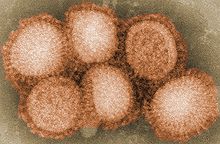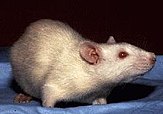Strain (biology)
In biology, a strain is a genetic variant, a subtype or a culture within a biological species. Strains are often seen as inherently artificial concepts, characterized by a specific intent for genetic isolation.[1] This is most easily observed in microbiology where strains are derived from a single cell colony and are typically quarantined by the physical constraints of a Petri dish. Strains are also commonly referred to within virology, botany, and with rodents used in experimental studies.[citation needed]
Microbiology and virology

It has been said that "there is no universally accepted definition for the terms 'strain', 'variant', and 'isolate' in the virology community, and most virologists simply copy the usage of terms from others".[2]
A strain is a
Artificial constructs
Scientists have modified strains of viruses in order to study their behavior, as in the case of the
In biotechnology, microbial strains have been constructed to establish metabolic pathways suitable for treating a variety of applications.[7] Historically, a major effort of metabolic research has been devoted to the field of biofuel production.[8] Escherichia coli is most common species for prokaryotic strain engineering. Scientists have succeeded in establishing viable minimal genomes from which new strains can be developed.[9] These minimal strains provide a near guarantee that experiments on genes outside the minimal framework will not be effected by non-essential pathways. Optimized strains of E. coli are typically used for this application. E. coli are also often used as a chassis for the expression of simple proteins. These strains, such as BL21, are genetically modified to minimize protease activity, hence enabling potential for high efficiency industrial scale protein production.[10]
Strains of yeasts are the most common subjects of eukaryotic genetic modification, especially with respect to industrial fermentation.[11]
Plants
The term has no official ranking status in botany; the term refers to the collective descendants produced from a common ancestor that share a uniform morphological or physiological character.[12] A strain is a designated group of offspring that are either descended from a modified plant (produced by conventional breeding or by biotechnological means), or which result from genetic mutation. [citation needed]
As an example, some
Rodents

A
Insects
The
See also
References
- PMID 10798550.
- PMID 23001720.
- S2CID 181077199.
- PMID 27123815.
- S2CID 84203734.
- ^ "Mutant flu". Nature News Special. Retrieved 21 April 2019.
- PMID 23656224.
- PMID 20822440.
- PMID 27903821.
- PMID 25792055.
- PMID 24724938.
- ISBN 978-1-85326-374-3
- ^ Maugh II, Thomas H. (18 February 2008). "Geneticist shaped hybrid rice strains - Los Angeles Times". Los Angeles Times.
- PMID 15771578.
- PMID 20936938.
- PMID 29290359.
